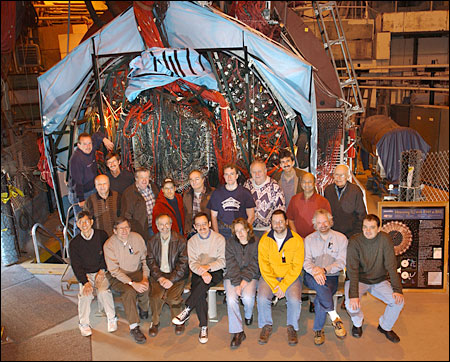Rare K Decay Update: Physicists Find Three More Candidates of Extremely Rare Process
August 18, 2008
Please note: This is an informational posting, not a Brookhaven press release.
An international team of physicists examining an extremely rare form of subatomic particle decay has discovered additional evidence for this process, which is highly sensitive to new forces beyond those incorporated in the Standard Model of particle physics. The innovative experiment, called "E949/E787" for its experiment numbers, is located at the U.S. Department of Energy's (DOE) Brookhaven National Laboratory. Three new candidate events were found, bringing the total observed to seven since the first sighting in 1997 (see E787 and E949). The result has been submitted to Physical Review Letters, and will be presented at a Physics Colloquium on Tuesday, August 19, 2008, at 3:30 p.m. in the Large Seminar Room, Building 510, Brookhaven Lab.
Further study will have to await a new generation of experiments in Europe or at a new accelerator in Japan where the Brookhaven experimental apparatus is planned to be sent.
The experiment discovered an extremely rare form of disintegration of an unstable subatomic particle called a K meson into three other particles - a positively charged pion (π+), which is observed, and an unseen neutrino (ν) antineutrino (ν) pair. This process (written K+→π+νν) is predicted by the Standard Model to occur only once in every 12 billion decays, making it one of the rarest decay processes ever observed. Its rate is extremely sensitive to new physical effects not accounted for in the Standard Model, making it one of the most interesting decay processes to study.
K+ mesons exist for only 12 billionths of a second before decaying. So to catch the fleeting events and identify the rare decay, the scientists built a state-of-the-art particle detector the size of a small house, capable of examining 1.6 million decays every second. Interesting events are recorded and physicists use sophisticated data-mining techniques to pore over the data to find the most promising events and examine them in exquisite detail.
This is the first time that any experiment has had enough sensitivity to observe candidate events in a region with lower energy pions. The study of these low-energy events is challenging due to background processes that can mimic the K+→π+νν process, so increasingly sophisticated analysis techniques were developed to exploit the full features of the detector to help exclude these background events.
The current result, based on all E949 and E787 data (seven events in total), indicates that the K+→π+νν process occurs once in every 5.8 billion decays - more than twice as often as predicted by the Standard Model. If confirmed with improved precision by future experiments, a deviation this large would be impossible to accommodate in the Standard Model, and would signal the existence of new fundamental physics effects.
The experimental collaboration - composed of 70 scientists from Canada, Japan, Russia and the United States - has been conducting the search for the past decade. Data collection concluded in 2002 when the Alternating Gradient Synchrotron accelerator used for this research became a dedicated injector to the Relativistic Heavy Ion Collider, another particle accelerator devoted to nuclear physics research. This research was funded by the Office of High-Energy Physics within DOE's Office of Science, with additional support from the Natural Sciences and Engineering Research Council and the National Research Council of Canada, and through U.S.-Japan and U.S.-Russia joint funding programs for collaborative research in high-energy physics.
For technical background, go here.
2008-844 | INT/EXT | Newsroom










